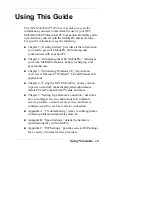
WinCEGeräte_Handbuch_Administration_v2 00_en
4 / 84
1 Overview
1.1 Purpose and scope of this manual
This document is intended as a set of instructions on the administration of the basic functions of
ACD Windows CE devices from the second edition (SE series). This manual covers topics that provide a
basic understanding of Windows CE functions as well as practical instructions for common recurring
administrative tasks.
The objective is to provide users with what they need to know in order to customise ACD Windows CE
devices to suit a specific customer application. This manual does not cover specific application settings;
reference will be made to separate documentation for this purpose.
Descriptions referring to programs or OS-proprietary setting dialogue boxes are based on the English
desktop language settings.
1.2 Windows CE operating system
Alongside other operating systems, the Microsoft operating system from the Compact series is installed on
ACD devices (referred to hereinafter as Windows CE 6). Windows CE 6 has extremely low memory and
processor performance requirements which allow an extremely energy-saving operation of the devices.
Although many features of this operating system resemble those of the "large" desktop Windows, for
example Windows 7, these operating systems have in fact little in common. As a rule, desktop Windows
programs or drivers cannot be launched under Windows CE 6. Application programming is the only aspect
where the operating systems display similarities however these are only of relevance to the software
developers.
This documentation applies to the M210SE, M215SE and M260SE ACD devices.
Differences between the individual devices are highlighted in the relevant chapters.
.NET CompactFramework 3.5 is installed on all devices mentioned below (under Windows CE 6). The SQL
Compact Server is also installed.
1.2.1 Integrated components and applications
Windows CE 6 is based on a monolithic kernel architecture that contains a subset of all available
components pre-defined by ACD. The majority of these components are provided by Microsoft and have
been specifically selected for the intended area of use of ACD devices. The scope of functions has been
extended to include special device drivers and ACD-proprietary programs used to adapt the devices to suit
special market requirements.





































